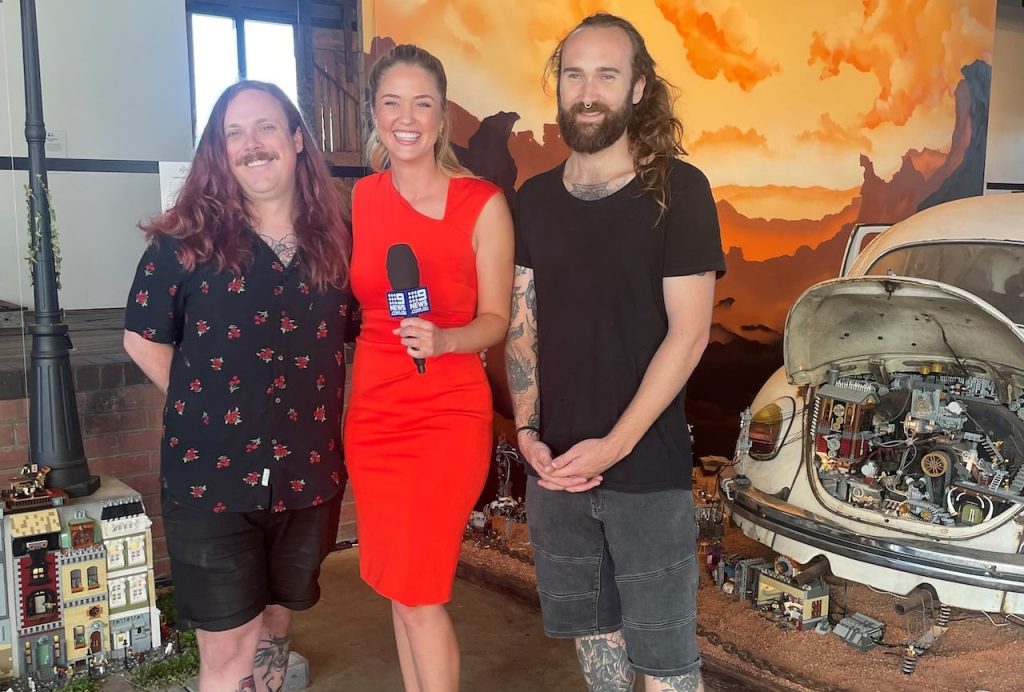Grandmas and grandads, time to dig out those dusty old boxes of Lego, buried away at the back of the shed and sit down with the grandkids to create a new masterpiece.
Jackson Harvey and Alex Towler from Perth won series two of Channel 9’s LEGO Masters, and they have created an immersive Lego exhibition, RELICS: Bricks of the New World, a prologue to the Scribblers Festival which runs from 3 to 9 May.
They spent two months getting an exhibition together which sees them using Lego in ways rarely seen before, incorporating found objects and mixed media into nine thought-provoking installations which used close to 250kg of Lego bricks.
The concept of the exhibition is that it is 2530 and humans have long since left planet Earth and Lego people have moved into all the old objects they have left behind. They have formed societies based around the functions of those objects – such as a piano, an arcade machine, and an old VW Beetle. Each of the civilisations living inside these objects they relate in some way to their home.
Nine’s LEGO Masters premiered season two last year with an average national audience of more than 1.2 million viewers each episode.
The season final where Harvey and Towler scooped the winning trophy made of Lego and a cash prize of $100,000 had an audience of more than 1.4 million viewers around the country.
The third season of LEGO Masters is coming soon.
The two high-school friends found that while they had different skill sets, they also had complimentary ones which gave them that winning combination for the show.
They both think the appeal of Lego is that it is more than a kid’s toy and a great way for grandparents to connect with their grandchildren.
Their earliest memories were getting Lego as birthday and Christmas presents. They feel that building things brings out everyone’s creative side and allows for the flow of conversations about design ideas. The guys say that it is a lot of fun using your hands, your creative mind, and a great tool for connecting.
They also say that Lego is not a single use toy – it is high quality, high use – and has a longevity than not many toys have these days. Lego bricks from the 50’s still work with Lego bricks made today.
Present buying was easy for Jackson growing up.

“I was given Lego for Christmas presents, birthday presents and everything in between – I had accumulated a lot of Lego by the time I was a teenager,” he says.
“Lego was my favourite thing growing up,” says Alex. “I used to have all the technic sets and would make tractors, trucks and little mechanisms – I think that was my young engineering brain getting excited.
“It is funny – you drift away from Lego when you get older – I definitely put Lego down for a long time – but now as an adult I see it differently.”
Harvey and Towler have collaborated with authors Cristy Burne and James Foley to create a free RELICS workbook that will allow younger viewers to continue their learning journey far beyond the exhibition.
LEGO’s founder, Ole Kirk Kristiansen, create the name Lego from taking the first two letters of the Danish words “leg godt” meaning play well. The company has passed from father to son and is now owned by Kjeld Kirk Kristiansen, a grandchild of the founder.
The famous Lego brick that we play with today is more than 50 years old. The bricks made way back in 1958 will still fit perfectly with those you play with today.
The moulds used to produce Lego bricks are accurate to within two-thousandth of a millimetre (0.002 mm). Because of this high degree of accuracy, only around 18 bricks in every million produced fail to meet the company’s high-quality standard.
Laid end to end, the number of Lego bricks sold in a year would reach more than five times round the world and on average there are 80 Lego bricks for every person on earth.
The free exhibition is on now at The Goods Shed, 4 Shenton Road, Claremont, from 9am to 3pm until 30 May.
For more info visit www.scribblersfestival.com.au/relics.